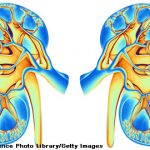NEW YORK (Reuters Health)—Although histomorphometry of iliac bone gives precise results, bone turnover markers provide a better reflection of the overall skeleton in untreated postmenopausal osteoporotic women, according to French researchers.
Bone histomorphometry allows study of bone remodeling at the basic structural unit level, Dr. Pascale Chavassieux and colleagues at the University of Lyon note in the Journal of Clinical Endocrinology and Metabolism, online Oct. 27.
However, the most sensitive and widely used markers of formation are serum osteocalcin, the bone isoenzyme of alkaline phosphatase (bone ALP) and the procollagen type 1 N-terminal propeptide (P1NP), they add.
To investigate the correlation between these approaches, the researchers conducted a post-hoc analysis of data from a previously published trial involving 371 women with at least one osteoporotic fracture. The team examined transilliac bone biopsies and blood samples.
Bone ALP and P1NP significantly correlated with both the static and dynamic parameters of bone formation. In addition, the resorption marker C-terminal crosslinking telopeptide of collagen type 1 significantly correlated with all resorption parameters.
“Bone turnover markers were significantly but modestly associated with bone turnover parameters measured at the tissue level in cancellous or endosteal compartments of iliac bone,” the researchers write.
They conclude that bone turnover markers “reflect the turnover of the entire skeleton, including the periosteal, cortical, endocortical and cancellous compartments when the histomorphometric parameters assess a small part of the iliac crest.”
Thus, they add, “Iliac cancellous bone provides useful information on the bone architecture, turnover and mineralization but variability exists across the skeletal sites.”
Dr. Chavassieux did not respond to requests for comment.
